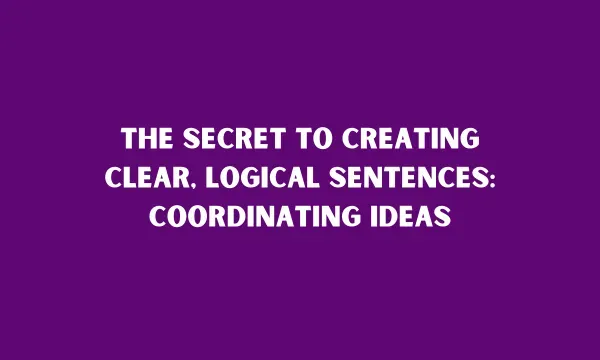The Secret to Creating Clear, Logical Sentences: Coordinating Ideas
Want to take your writing to the next level? Mastering coordination is key.
When you coordinate ideas, you link words, phrases, or clauses that carry equal weight in a sentence. This creates logical flow that helps readers follow your meaning.
For example:
- The Pathfinder lander was sending back its first images of the surface of Mars, and everyone was focused on the television screens. (Matthew P. Golombek, “The Mars Pathfinder Mission”)
- Crisp foods have to be loud in the upper register; foods which generate low-frequency rumblings are crunchy, or slurpy, but not crisp.
To coordinate ideas, use connecting words:
- For addition: and, as well as, besides, both...and (Basketball players are generally tall, fit, and quick.)
- For contrast: but, however, nevertheless, still, yet (Nell looked for her wallet, but she couldn’t find it anywhere.)
- For choice: either...or, neither...nor, nor, or, otherwise (Either Regina or Bookie will go to the movie with me.)
- For result: accordingly, consequently, for, hence, so, therefore, thus (Mack’s hair was uncombed; consequently, he looked too messy for the photo.)
Choose connectives carefully to show the precise relationship between ideas. Using the wrong connector muddles meaning.
You can coordinate single words, phrases, subordinate clauses, or independent clauses. With independent clauses, put a comma before the conjunction unless clauses are very short.
Coordinating ideas transforms choppy sentences into sophisticated, elegant ones. It creates crossover between phrases that tells readers how ideas connect logically. Your writing will flow better, keeping readers engaged.
For clear, logical writing, coordination is essential. Use these tips to link ideas and take your writing up a level!
<->
Here are some sample FAQs for the blog post on coordinating ideas:
What is coordination in writing?
Coordination refers to linking words, phrases, or clauses that carry equal importance in a sentence. It creates logical flow and clarity.
Why use coordination in my writing?
Using coordination creates sophisticated, elegant sentences that help readers follow your ideas easily. It transforms choppy writing into smooth, engaging prose.
When should I use coordination?
Use coordination when you have ideas of equal weight that need to be connected in sentences and paragraphs. Link related ideas to show how they fit together.
What are coordinating conjunctions?
Coordinating conjunctions like "and", "but", and "or" link coordinate ideas and show the relationship between them (addition, contrast, choice, etc).
How do I punctuate coordinated ideas?
Use a comma before a coordinating conjunction connecting independent clauses, unless the clauses are very short. Use a semicolon before a conjunctive adverb.
Should every sentence use coordination?
No, variety is good in writing. But strategic coordination can create flow between sentences and improve clarity overall. Use judgment.
How do I know which coordinating connector to use?
Choose connectives carefully to show the precise relationship between the ideas being connected (addition, contrast, result, etc).
What if I'm unsure how to coordinate ideas?
Read the sentences aloud and think about the relationship between the ideas. Practice using different conjunctions to find the best fit.
References:
- "Compound Sentences." The Writing Center, University of North Carolina at Chapel Hill.
- "Coordinating Conjunctions." The Writing Center, University of North Carolina at Chapel Hill.
- "Punctuating Coordinate Adjectives." The Writing Center, University of North Carolina at Chapel Hill.
- "Comma Usage." The Writing Center, University of North Carolina at Chapel Hill.

